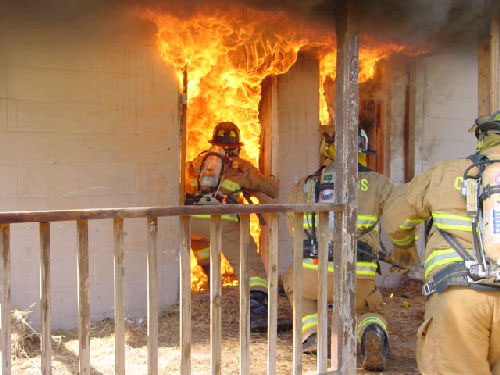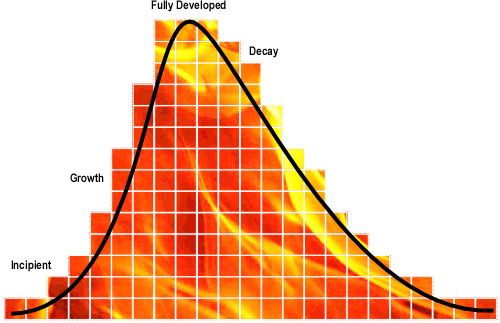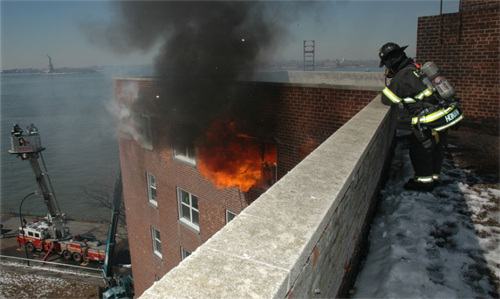Real Backdraft?
Wednesday, September 9th, 2009I had intended to continue discussion of flame indicators in this post, but was motivated to address a common fire service myth based on information presented in an article in the New Canaan (Connecticut) Advertiser’s on-line newspaper titled Real ‘Backdraft’.
Figure 1. Backdraft Demonstration

Note: Photos of backdraft demonstration at the Swedish Civil Contingencies Agency College in Revinge, Sweden by Ed Hartin
The Question
The article was written by a fire officer in response to the question” “is there really such a thing as a backdraft as depicted in the 1991 Ron Howard movie by the same name?” His response to the question:
I found the movie very entertaining; however, I was completely distracted by the unrealistic depiction of fire and how it behaved compared to real life. . . . A backdraft occurs when a fire, in a confined space (room or building), has used up the available air and begins to starve for oxygen. When this occurs, great quantities of carbon monoxide (CO) are produced.
We all know that CO is the odorless, colorless and tasteless gas that can kill us. Another lesser known fact is that it is also highly flammable – like propane or natural gas.
This last characteristic is the catalyst for a backdraft. If a door or window is opened and a fresh supply of oxygen is introduced at the right (wrong) time, all of the built up CO will explode with devastating results.
Most action adventure films fail to depict fires and firefighting accurately, fueling (no pun intended) the public’s misperception of the hazards presented in the fire environment. While not likely the result of watching Backdraft and Ladder 49, many fire behavior myths and misperceptions persist in the fire service as well.
Fire Service Myth
The response to the question about backdraft is partially correct, this phenomenon involves introduction of air to a ventilation controlled fire. However, presumption that carbon monoxide is the predominant fuel in backdraft is a common fire service myth that is not supported by scientific research.
As observed by Gorbett and Hopkins (2007), there is considerable misunderstanding about extreme fire behavior such as flashover and backdraft. For example, many fire service texts and standards (e.g., National Fire Protection Association (NFPA) 402 Guide for Aircraft Rescue and Fire-Fighting Operations) continue to perpetuate the misconception that carbon monoxide concentration is a major determinant in the occurrence of backdraft.
Scientific Evidence
A substantial number of scientific studies have demonstrated that the major component of gas phase fuel involved in backdraft phenomenon is unburned, excess pyrolizate from solid fuel (Gottuk, 1999; Gojkovic, 2000; Sutherland, 1999; Fleischmann, 1993; Fleischmann & Pagni, 1993; and Weng & Fan, 2003). While backdraft conditions develop under ventilation controlled conditions with lower than normal (21%) oxygen concentration, the concentration of total hydrocarbons is the primary determinant of backdraft potential (Fleischmann, 1992 Weng & Fan, 2003).
As illustrated in Figure 2, smoke from incomplete combustion of organic materials includes a substantial concentration of unburned pyrolysis products. containing considerable potential (chemical) energy. If this gas phase fuel accumulates in sufficient concentration while the fire is in decay due to limited oxygen, an increase in ventilation may result in a backdraft.
Figure 2. Multi-Compartment Doll’s House Demonstration, Klana Croatia

Note: Photo by Nikola Tramontana, Vatrogasci Opatija, Croatia.
As actor and author Will Rogers said “It’s not what we don’t know that hurts, it’s what we know that ain’t so.” What I learned about fire behavior as a recruit firefighter was incomplete and in some cases inaccurate. I don’t fault the instructors or the textbook that was used as both were the best available at the time. However, it is important that we continue to push at the edges of our understanding of fire behavior and recognize that what we recognize as fact today may not be so tomorrow.
For more information on the backdraft phenomenon, see:
- Hazard of Ventilation Controlled Fires
- Smoke Explosion or Backdraft?
- Language & Understanding: Extreme Fire Behavior
- 15 Years Ago: Backdraft at 62 Watts Street
- 62 Watts Street: Modeling the Backdraft
- Extreme Fire Behavior: An Organizational Scheme (Ontology)
- Gas Explosions
- Gas Explosions Part 2
Barring another target of opportunity, my next post will return to Reading the Fire and revision and extension of the Flame Indicators concept map.
Ed Hartin, MS,EFO, MIFireE, CFO
References
Fleischmann, C. & Pagni, P. (1993) Exploratory backdraft experiments.” Fire Technology, 29(4), 298-316
Fleischmann, C. (1993) Backdraft phenomena, National Institute for Standards and Technology NIST-CGR-94-646). Retrieved March 26, 2009 from http://fire.nist.gov/bfrlpubs/fire94/PDF/f94008.pdf
Gojkovic, D. (2000) Initial backdraft experiments, Lund University. Sweden
Gorbett, G. & Hopkins, R. (2007). The Current Knowledge and Training Regarding Flashover, Backdraft, and Other Rapid Fire Progression Phenomenon. Retrieved March 19, 2009 from http://www.kennedy-fire.com/backdraft%20paper.pdfGottuk, D., Peatross, M., Farley, J. Williams, F. (1999) The development and mitigation of backdraft: A real-scale shipboard study. Fire Technology 33(4), 261-282.
Sutherland, B. (1999) Smoke sxplosions. University of Canterbury: Department of Engineering. Christchurch, New Zealand
Weng, W. & Fan, W. (2003). Critical condition of backdraft in compartment fires: A reduced scale experimental study. Journal of Loss Prevention in the Process Industries, 16, 19-26.


























